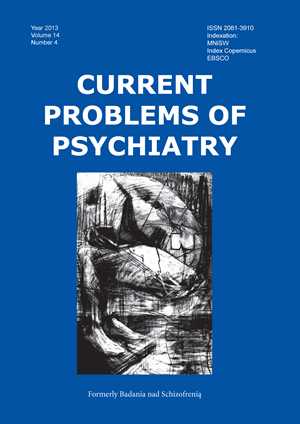Comparison of intensification of mobile phone addiction in Polish, Taiwanese and American students
Keywords:
mobile phone, addiction, adolescentsAbstract
The aim of the research was the verification of the hypothesis assuming the occurrence of statistically significant differences between the students from Poland, Taiwan and the USA as regards the intensification of mobile phone addiction.
Material and Methods. The total group of examined students, studying in Poland, numbered 147 and it consisted of 83 Poles, 31 Taiwanese and 33 Americans, their average age being 21. The following research methods were used in the research: the Survey Form and the Mobile Phone Assessment Addiction developed by Potembska and Pawłowska.
Results and conclusions.
- Taiwanese and American students show significantly more intensified mobile phone addiction symptoms as compared to their Polish peers.
- More students from Taiwan (55%) fulfil the criteria of being at risk of developing the mobile phone addiction as compared to the American students (39%) and Polish students (22%).
- As compared to the American and Polish students, the students from Taiwan prefer using mobile phones to talk to other people and text them instead of “face to face” encounters.
- As compared to the Polish students, the students from Taiwan and the USA significantly more often buy the latest models of mobile phones. Their use of the mobile phone includes listening to music, taking pictures, making films and sending them to their friends as well as playing games and going online.
- The Taiwanese students, as compared to their Polish peers, show intensified symptoms of addiction to talking on the mobile phone and texting, moreover, they use a mobile phone to satisfy the need for acceptance, affiliation and self-disclosure.
References
1. Pawłowska B, Potembska E. Objawy zagrożenia i uzależnienia od telefonu komórkowego mierzonego Kwestionariuszem do Badania Uzależnienia od Telefonu Komórkowego, autorstwa Potembskiej i Pawłowskiej u młodzieży w wieku do 13 do 24 lat. Curr. Probl. Psychiatry, 2011; 12(4): 395-397.
2. Pawłowska B., Dziurzyńska E., Gromadzka K., Wallace B.E, Zygo M. Objawy uzależnienia od telefonu komórkowego a korzystanie z internetowych portali społecznościowych przez młodzież. Curr. Probl. Psychiatry 2012; 13(2):103-108.
3. Griffiths MD. Gambling on the internet: a brief note. J Gambl Stud, 1996; 12: 471-473.
4. Young K.S. Internet addiction: the emergence of a new clinical disorder. Cyberpsychol. Behav., 1998; 1(3): 237-244.
5. Martinotti G, Villella C, Di Thiene D. et al. Problematic mobile phone use in adolescence: a cross-sectional study. J Public Health 2011; 19(6): 545-551.
6. Sánchez-Martínez M, Otero A. Factors associated with cell phone use in adolescents in the community of Madrid (Spain). Cyberpsychol. Behav., 2009; 12(2): 131-137.
7. Yang YS, Yen JY, Ko CH, Cheng CP, Yen CF The association between problematic cellular phone use and risky behaviors and low self-esteem among Taiwanese adolescents. BMC Public Health, 2010; 10: 217-223.
8. Lu X, Watanabe J, Liu Q, Uji M, Shono M, Kitamura T. Internet and mobile phone text-messaging dependency: Factor structure and correlation with dysphoric mood among Japanese adults. Comput. Human Behav., 2011; 27(5): 1702-1709.
9. Potembska E, Pawłowska B. Płeć a uzależnienie od telefonu komórkowego u gimnazjalistów. Fam. Med. Prim. Care Rev., 2010; 12(3): 800-801.
10. Potembska E., Pawłowska B. Właściwości psychometryczne Kwestionariusza do Badania Uzależnienia od Telefonu Komórkowego (KBUTK). Bad. Schizofr., 2009; 10: 322-329.
11. SIIPaC (Società Italiana Intervento Patologie Compulsive)Mobile Addiction Test. 2010. www.siipac.it.
12. Pawłowska B., Masiak J. A comparison of severity of symptoms of Internet addiction in students from Poland, Taiwan and the USA. Curr. Probl. Psychiatry, 2014; 15(1) (praca w druku).


